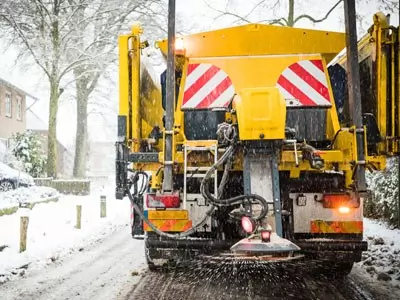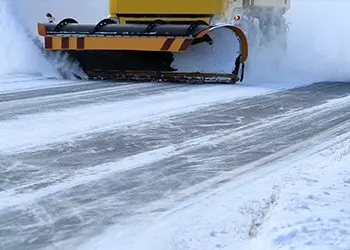Should You Grit Your Car Park When It Is Icy?
Should you grit your car park when it is icy? We look at the reasons why it is beneficial to grit the carpark of your business during wither months.
Who is responsible for the safety of a private car park?
The responsibility for the safety of a private car park falls to the car park owners by law, unlike public car parks which are normally gritted by the local borough and district councils.
The owner of the private car park has a duty of care for visitors and staff and is liable for anything that happens on the property, as stated in the occupiers liability act 1957.
To improve the safety of the car park it is advised to carry out the following steps;
perform a risk assessment to see what areas will be prone to slippery ice and snow and which are used most by vehicles, employees and visitors.

Monitor temperatures and weather forecasts for when cold weather is predicted and use grit or salt on the surfaces to ensure the safety of pedestrians, signs can also be used to direct people to safer pathways.
Cold weather can also come with other risks, such as falling leaves, strong winds, flooding or heavy rain, the owner must take out necessary precautions and have a plan in place for these conditions.
Advice by the Health and Safety Executive (HSE)
Winter weather can come with lots of hazards and risks that can lead to injury at the workplace. Health and Safety Executive have plenty of legal advice and tips to reduce these risks and make your car park as safe as possible.
Lighting during the winter months can oppose a problem as there are reduced hours of daylight, ask employees if the current lighting in your car park suffices, if it doesn't, add lights where necessary.

Wet and decaying leaves that have fallen can hide hazards and cause pedestrians to slip, management can remove these regularly or consider removing the bushes and trees causing this issue completely.
Slipping accidents are commonly caused by heavy rainfall, if rain is being brought into the entrance to the site add a canopy or other shelter to the walkways into the building along with mats to soak up the water.
Ice, frost and snow bring many risks to both cars and pedestrians, carry out an annual risk assessment and monitor the temperature.
Grit the ground used by cars and people and use signs to make everybody aware of the dangers, also barrier off areas that are not gritted and divert users to a safe pathway or car routes. A better but more expensive alternative is to invest in an automatic sign that will light up when temperatures drop below a certain degree.
Car Park Safety During Winter
Car park owners are responsible for the health and safety of their employees, they have a duty of care especially during the winter and autumn months as these are the most dangerous for road users and pedestrians.
This means any debris, rubbish, branches and leaves should be cleared to make a free pathway, signs should also be used to indicate any areas that are prone to these problems.
Excessive rain could cause flooding so be sure to have flood barriers if your premises is prone to flooding, have well-placed footpaths for access to the building and place warning signs for both pedestrians and vehicles.
Fallen leaves can be just as slippery as ice so treat them with the same significance, make sure pathways into the building prevent pedestrians from treading the slippery decaying leaves into the premises.
Fallen leaves may also hide any other hazards in the car park so have them cleared regularly.
Windy weather most likely means twigs and debris will have blown onto your car park, these may not oppose a risk but bigger branches may be a tripping hazard for pedestrians and cause damage to vehicles.
Be sure to have these cleared as regularly as possible, or if it becomes a constant issue, replace the bushes and trees in question.

Snow and ice are a more obvious hazard to take into consideration when carrying out a risk assessment on your car park, ensure the used footpaths and roads are gritted in good time, not forgetting slopes that can be especially dangerous so insert a handrail that services the public.
Finally, it may be a good idea to impose speed bumps or reduce speed signs to reduce the risk of speeding in the car park and make users aware of the dangers.
Solutions for a safer car park
As the owner of a business, you have a responsibility to ensure safety to visitors and pedestrians and you need to take necessary precautions to prevents accidents and injury in your car park.
Icy conditions- From the get-go, you should choose a slip-resistant surface for your car park and pathways, this will provide better grip in wet and icy conditions.
An annual risk assessment will outline the hazards that snow and ice bring, you must then take all reasonably practicable steps to minimise the risk, for example monitoring temperatures and gritting heavily-trafficked areas.
Heavy rain and fallen leaves- fallen leaves may not seem like much harm but they can hide damage to roads or potholes and cause pedestrians to slip or fall. Placing pathways where there is less risk of this and setting up signs to warn people of the slippery areas would be a reasonable solution.
Is gritting the best solution to icy car parks?
Gritting is the most common solution to icy car parks and for good reason, it is reasonably cheap and easy to apply, rock salt takes longer as it relies on vehicles and pedestrians to spread it.
Salt also needs to be applied before the ice and snow appear, typically the night before, this risks the salt being washed away by heavy rainfall. That being said, salt is more effective for grip on slippery surfaces and will also protect the ground from freezing further if the temperature drops again later in the day/night.
We offer rock salt spreading throughout Aberdeen, Peterhead, Dundee and Aberdeenshire. Follow the link below to find out more about the areas that we offer road gritting in north Scotland.

